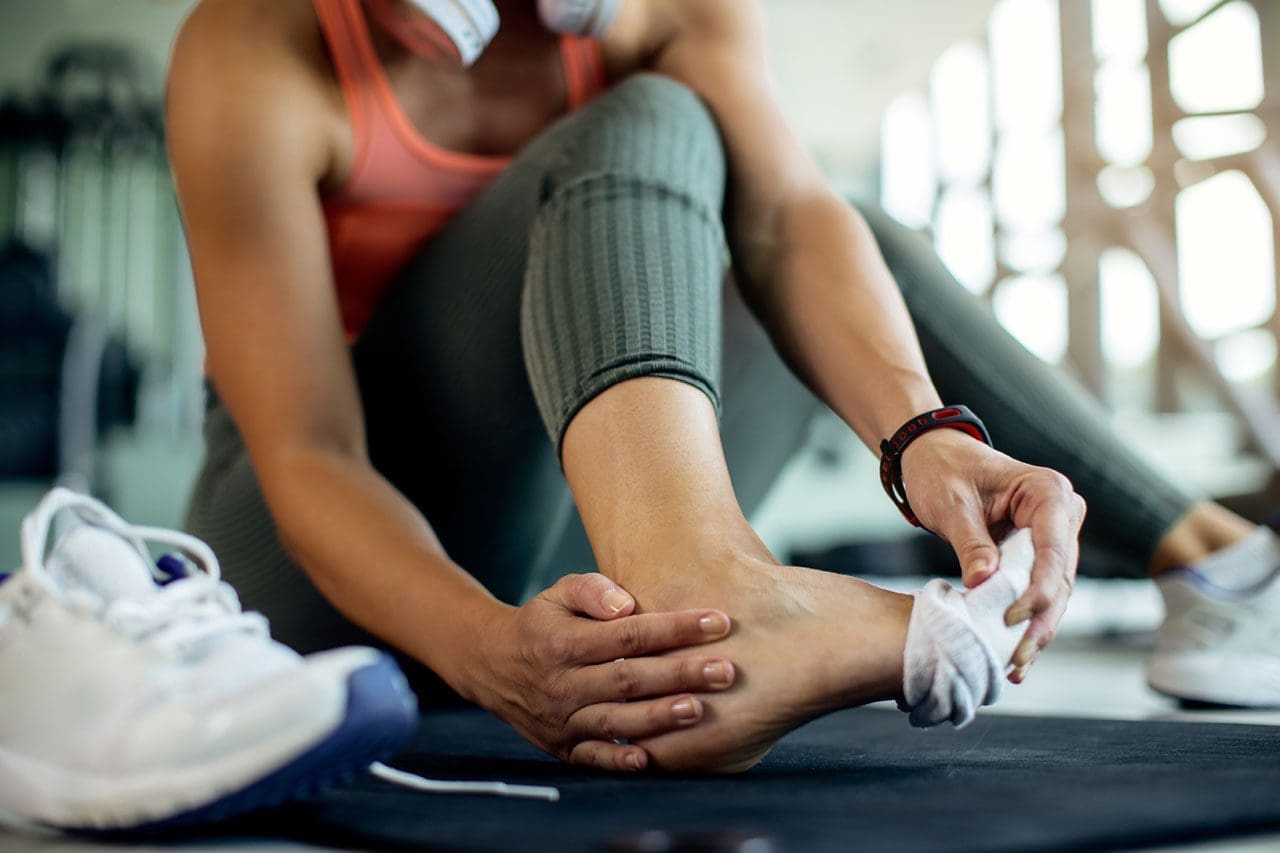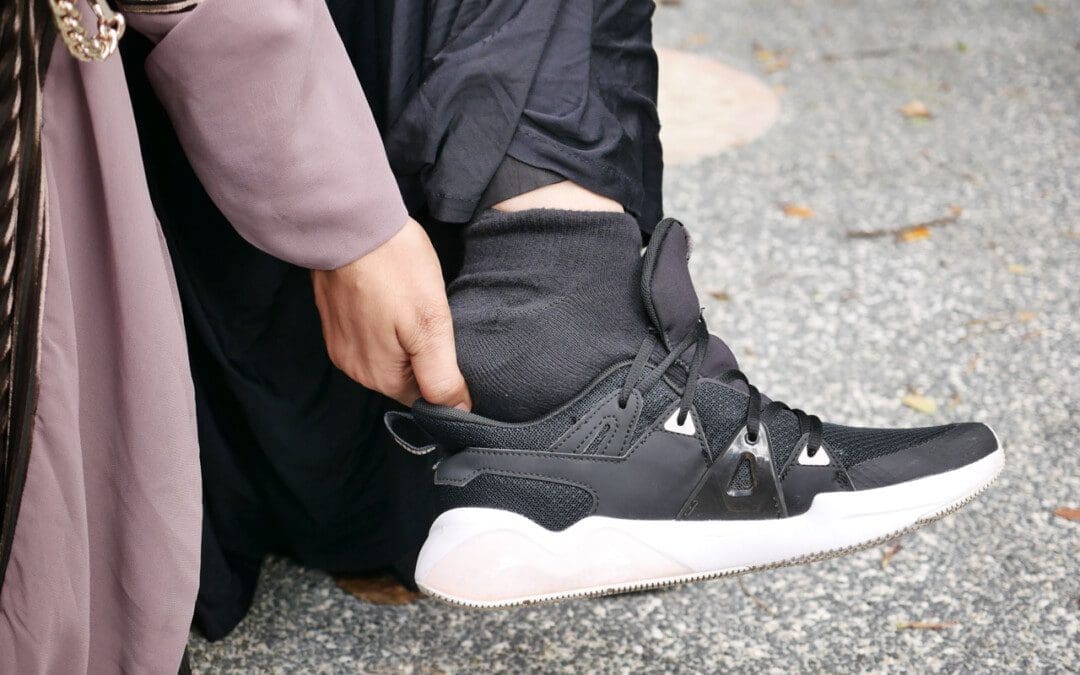Individuals’ feet will heat up when walking or running; however, burning feet could be a symptom of medical conditions like athlete’s foot or a nerve injury or damage. Can awareness of these symptoms help identify solutions to relieve and heal the underlying condition?

Contents
Burning Feet
Walkers and runners often experience heat in their feet. This is natural from the increased circulation, heart rate, warm or hot sidewalks, and pavement. But the feet could experience an abnormal hot or burning sensation. Usually, the overheating is caused by socks and shoes and fatigue after a long workout. The first self-care steps include trying new or specialized footwear and workout adjustments. If burning feet persist or there are signs of infection, tingling, numbness, or pain, individuals should see their healthcare provider. (Mayo Clinic. 2018)
Footwear
The shoes and how they are worn may be the cause.
- First, look at the material of the shoes. They could be shoes and/or insoles that don’t circulate air. They can get hot and sweaty without proper air circulation around the feet.
- When choosing running shoes, consider a mesh material that allows airflow to keep the feet cool.
- Consider getting fitted for shoes that are the right size, as the feet swell when running or walking.
- If the shoes are too small, air can’t circulate, creating more friction between the foot and the shoe.
- Shoes that are too large can also contribute to friction as the feet move around too much.
- Insoles could also contribute.
- Some insoles can make the feet hot, even if the shoes are breathable.
- Swap the insoles from another pair of shoes to see if they are contributing, and if so, look into new insoles.
Tips to help prevent hot feet:
Topical Ointments
- Use an anti-blister/chafing topical cream to lubricate and protect the feet.
- This will reduce friction and prevent blisters.
Lace Properly
- Individuals may be lacing the shoes too tight, constricting circulation, or irritating the nerves at the top of the foot.
- Individuals should be able to slide one finger under the knot.
- Remember that the feet will swell as walking or running commences
- Individuals may need to loosen their laces after warming up.
- Individuals are recommended to learn lacing techniques that will ensure they are not too tight over the sensitive areas.
Cushioning
- Fatigue from long workouts or long days standing/moving can result in burning feet.
- Individuals may need added cushioning in the shoes.
- Look for work and athletic shoes that have added cushioning.
Shoe Allergies
Individuals may have an allergic reaction or a sensitivity to the fabric, adhesives, dyes, or other chemicals. (Cleveland Clinic. 2023) The chemicals used in production vary for leather compared to fabric and are different by brand and manufacturer.
- A shoe material allergy may also result in burning, itching, and swelling.
- It’s recommended to note whether symptoms only happen when wearing a specific pair of shoes.
- Recommendations are to try different kinds and brands of shoes.
Socks
The sock fabric could be contributing to hot or burning feet. Steps to take can include:
Avoid cotton
- Cotton is a natural fiber but is not recommended for walking and running as it holds sweat that can keep the feet wet.
- It is recommended to use socks made of Cool-Max and other artificial fibers that wick sweat away and cool them down.
Wool
- Wool socks can also cause itching and burning sensations.
- Consider athletic socks made from itch-free wool.
Mindfulness
- Individuals could be sensitive to other fabrics or dyes in socks.
- Take note of which socks cause hot or burning feet symptoms.
- Individuals could also be sensitive to laundry products and are recommended to try a different brand or type.
Medical Conditions
In addition to shoes and socks, medical conditions could cause and contribute to symptoms.
Athlete’s Foot
- Athlete’s foot is a fungal infection.
- Individuals may feel a burning sensation in the affected area.
- Typically, it is itchy, red, scaling, or cracking.
- Rotate shoes.
- The fungus grows in damp places, therefore, it is recommended to rotate shoes to allow them to dry out between workouts.
- Wash and dry the feet after walking or running.
- Try home and over-the-counter solutions, powders, and remedies to treat athlete’s foot.
Peripheral Neuropathy
Individuals frequently experiencing burning feet apart from when they have been exercising could be due to nerve damage known as peripheral neuropathy. (National Institute of Neurological Disorders and Stroke. 2023) Peripheral neuropathy symptoms include pins and needles, numbness, tickling, tingling, and/or burning sensations.
Examination
- Diabetes is one of the most common causes of peripheral neuropathy.
- Diabetes can come on at any age.
- Individuals need to learn how to protect their feet, as exercise is recommended for diabetes.
Other conditions that can produce peripheral neuropathy include:
- Vitamin B-12 deficiency
- Alcohol abuse
- Circulatory disorders
- AIDS
- Heavy metal poisoning
Massage and Movement
- Massaging the feet also increases circulation.
- Exercise such as walking is recommended for peripheral neuropathy as it improves circulation to the feet.
Other Causes
Symptoms could also be caused by other conditions including: (Cleveland Clinic. 2023)
Nerve Entrapment
- Degenerative changes in the spine or back trauma can cause injury/damage to the nerves that can cause pain, tingling, and numbness in the feet.
Tarsal Tunnel Syndrome
- Compression of the posterior tibial nerve in your lower leg can cause tingling and burning in your feet.
Morton’s Neuroma
- Morton’s neuroma, which is caused by thickened nerve tissue, can cause pain and burning at the base of the toes.
Autoimmune Diseases
- Diseases such as multiple sclerosis or Lupus can also cause burning feet.
Self-Care
Adjustments or additions to routines and habits can help.
- Don’t walk or run in worn-out shoes.
- Protect the feet by using the right socks, foot powder, and ointments, and cover any areas where rubbing and friction occur.
- Immediately change out of shoes and socks after exercise, allowing thorough air drying.
- This will help reduce the risk of the athlete’s foot fungus growth.
- Soak the feet in cool water. Do not use ice, as it could damage the skin.
- Soak the feet in Epsom salts to relieve pain and inflammation and dry up blisters.
- Elevate the feet after exercising.
- Rotate the shoes and socks between workout sessions and during the day.
- Try different shoes, socks, and insoles.
- Overtraining can worsen symptoms.
- Try gradually building on distance while monitoring symptoms.
See a doctor or specialist healthcare provider if symptoms continue and are not associated with walking or running exercise.
Exploring Integrative Medicine
References
Mayo Clinic. (2018). Burning Feet.
National Institute of Neurological Disorders and Stroke. (2023). Peripheral Neuropathy.
Cleveland Clinic. (2023) Burning Feet Syndrome.
General Disclaimer, Licenses and Board Certifications *
Professional Scope of Practice *
The information herein on "How to Deal With Burning Feet When Running and Walking" is not intended to replace a one-on-one relationship with a qualified health care professional or licensed physician and is not medical advice. We encourage you to make healthcare decisions based on your research and partnership with a qualified healthcare professional.
Blog Information & Scope Discussions
Welcome to El Paso's Premier Wellness and Injury Care Clinic & Wellness Blog, where Dr. Alex Jimenez, DC, FNP-C, a Multi-State board-certified Family Practice Nurse Practitioner (FNP-BC) and Chiropractor (DC), presents insights on how our multidisciplinary team is dedicated to holistic healing and personalized care. Our practice aligns with evidence-based treatment protocols inspired by integrative medicine principles, similar to those on this site and on our family practice-based chiromed.com site, focusing on naturally restoring health for patients of all ages.
Our areas of multidisciplinary practice include Wellness & Nutrition, Chronic Pain, Personal Injury, Auto Accident Care, Work Injuries, Back Injury, Low Back Pain, Neck Pain, Migraine Headaches, Sports Injuries, Severe Sciatica, Scoliosis, Complex Herniated Discs, Fibromyalgia, Chronic Pain, Complex Injuries, Stress Management, Functional Medicine Treatments, and in-scope care protocols.
Our information scope is multidisciplinary, focusing on musculoskeletal and physical medicine, wellness, contributing etiological viscerosomatic disturbances within clinical presentations, associated somato-visceral reflex clinical dynamics, subluxation complexes, sensitive health issues, and functional medicine articles, topics, and discussions.
We provide and present clinical collaboration with specialists from various disciplines. Each specialist is governed by their professional scope of practice and their jurisdiction of licensure. We use functional health & wellness protocols to treat and support care for musculoskeletal injuries or disorders.
Our videos, posts, topics, and insights address clinical matters and issues that are directly or indirectly related to our clinical scope of practice.
Our office has made a reasonable effort to provide supportive citations and has identified relevant research studies that support our posts. We provide copies of supporting research studies upon request to regulatory boards and the public.
We understand that we cover matters that require an additional explanation of how they may assist in a particular care plan or treatment protocol; therefore, to discuss the subject matter above further, please feel free to ask Dr. Alex Jimenez, DC, APRN, FNP-BC, or contact us at 915-850-0900.
We are here to help you and your family.
Blessings
Dr. Alex Jimenez DC, MSACP, APRN, FNP-BC*, CCST, IFMCP, CFMP, ATN
email: coach@elpasofunctionalmedicine.com
Multidisciplinary Licensing & Board Certifications:
Licensed as a Doctor of Chiropractic (DC) in Texas & New Mexico*
Texas DC License #: TX5807, Verified: TX5807
New Mexico DC License #: NM-DC2182, Verified: NM-DC2182
Multi-State Advanced Practice Registered Nurse (APRN*) in Texas & Multi-States
Multi-state Compact APRN License by Endorsement (42 States)
Texas APRN License #: 1191402, Verified: 1191402 *
Florida APRN License #: 11043890, Verified: APRN11043890 *
License Verification Link: Nursys License Verifier
* Prescriptive Authority Authorized
ANCC FNP-BC: Board Certified Nurse Practitioner*
Compact Status: Multi-State License: Authorized to Practice in 40 States*
Graduate with Honors: ICHS: MSN-FNP (Family Nurse Practitioner Program)
Degree Granted. Master's in Family Practice MSN Diploma (Cum Laude)
Dr. Alex Jimenez, DC, APRN, FNP-BC*, CFMP, IFMCP, ATN, CCST
My Digital Business Card
Licenses and Board Certifications:
DC: Doctor of Chiropractic
APRNP: Advanced Practice Registered Nurse
FNP-BC: Family Practice Specialization (Multi-State Board Certified)
RN: Registered Nurse (Multi-State Compact License)
CFMP: Certified Functional Medicine Provider
MSN-FNP: Master of Science in Family Practice Medicine
MSACP: Master of Science in Advanced Clinical Practice
IFMCP: Institute of Functional Medicine
CCST: Certified Chiropractic Spinal Trauma
ATN: Advanced Translational Neutrogenomics
Memberships & Associations:
TCA: Texas Chiropractic Association: Member ID: 104311
AANP: American Association of Nurse Practitioners: Member ID: 2198960
ANA: American Nurse Association: Member ID: 06458222 (District TX01)
TNA: Texas Nurse Association: Member ID: 06458222
NPI: 1205907805
| Primary Taxonomy | Selected Taxonomy | State | License Number |
|---|---|---|---|
| No | 111N00000X - Chiropractor | NM | DC2182 |
| Yes | 111N00000X - Chiropractor | TX | DC5807 |
| Yes | 363LF0000X - Nurse Practitioner - Family | TX | 1191402 |
| Yes | 363LF0000X - Nurse Practitioner - Family | FL | 11043890 |








